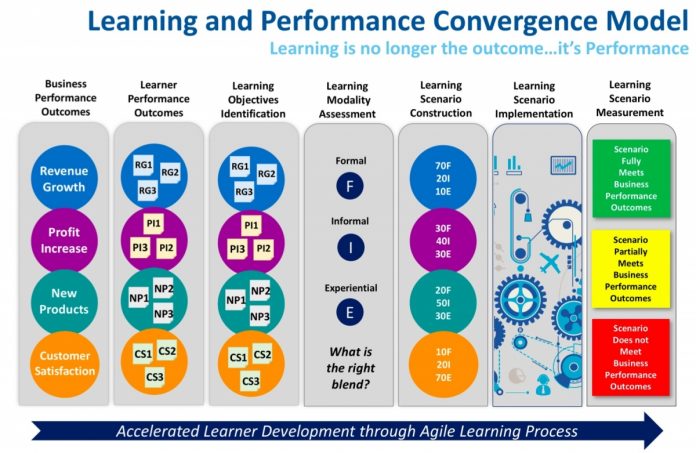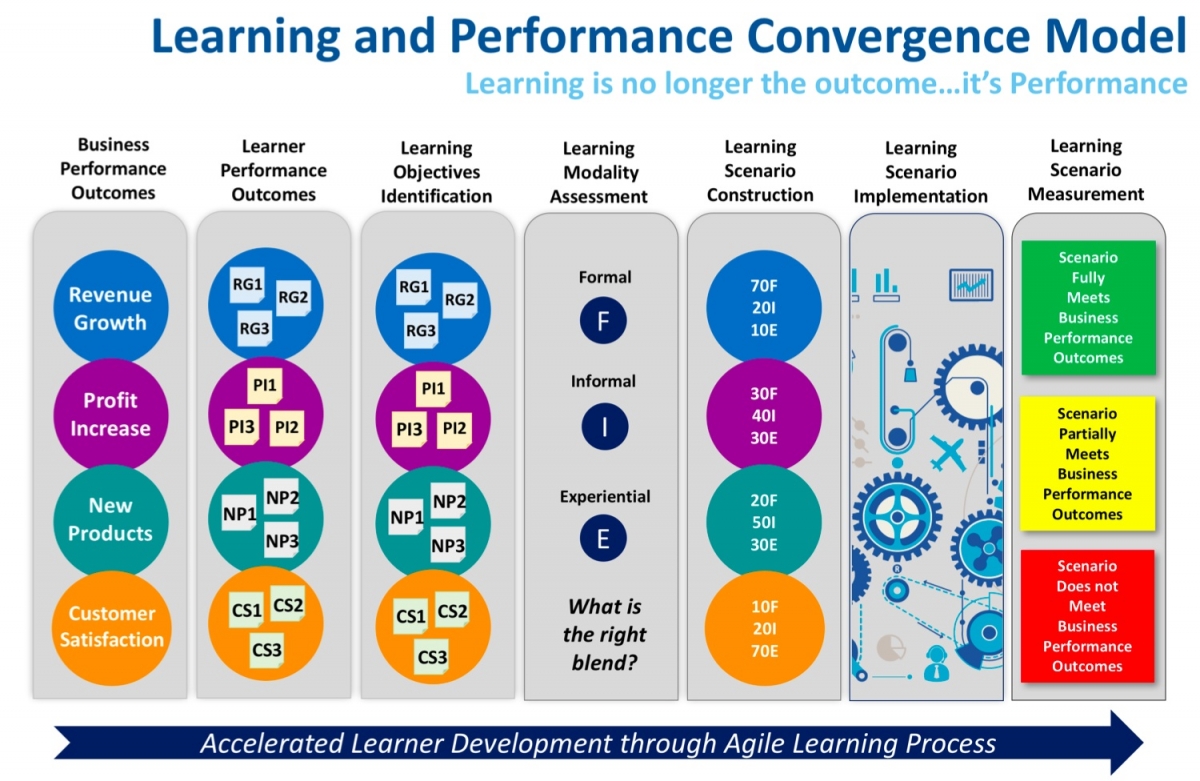
Organizations have been talking about delivering a blended learning experience for years. Until recently, however, “blended” typically meant some mix of classroom training and e-learning. Within the greater context of how people learn, this mix isn’t truly blended at all. It is 100 percent focused on delivering formal learning experiences.
Now, organizations finally are beginning to come to grips with the fact that formal learning represents a relatively small percentage of how people learn. The most common principle cited is the 70:20:10 model, which states that people acquire knowledge in this ratio: 70 percent experiential, 20 percent informal, and 10 percent formal.
If you combine this with the Ebbinghaus Forgetting Curve, which states that people forget about 75 percent of what they learn in a formal setting within a week, it is easy to conclude that organizations spend far too much time, money, and resources on formal learning.
The good news is that new technologies have greatly enhanced a company’s ability to deliver other types of learning. In other words, technology used to dictate how we learn; now it can be leveraged to empower us to learn in ways that come more naturally.
What Does Truly Blended Learning Entail?
First and foremost, it does not mean the end of the classroom, or formal learning in general. In fact, we expect the classroom to continue to be the No. 1 delivery method for learning.
Formal learning can—and should be—the center of an effective blended learning strategy. Companies need to approach formal learning from a new, blended mindset—as a start or a centerpiece, rather than an endpoint.
The 70:20:10 framework is just that—a framework. It is a model that can be used to guide how companies approach their learning. It is by no means a prescription or a precise formula. But recognizing that people learn in many more different ways than a class or course alone can deliver is the first step in delivering an effective blended learning environment.
The Learning-Performance Convergence Model
Unshackled from traditional formal learning and strict adherence to a 20-year-old model, organizations are poised to deliver learning that is focused on behaviors and performance. In traditional learning models, success is measured in completions, grades, and smile sheets.
A fluid, blended approach to learning is focused on specific outcomes aimed at changing how people work and improve the business. To that end, Brandon Hall Group has developed The Learning-Performance Convergence Model, which shows how the three elements of the 70:20:10 model can be used in variable ways to connect learning to performance.
The model is based on the results of multiple studies conducted by Brandon Hall Group, as well as engagements with leading-edge companies, solution providers, and thought leaders.
Figure 1 (downloadable at the end of this article):

Source: Brandon Hall Group 2017
In Brandon Hall Group’s latest Learning Strategy Study, we found that the overwhelming majority of companies that take a blended approach to learning see an improved link between learning and individual performance (95 percent), and organizational performance (91 percent).
Within the context of the Learning & Performance Convergence Model, companies need to understand that:
- Blended learning is not a by-the-numbers application of 70:20:10.
- Blended learning is not a sequential rollout of formal first, then informal, then experiential learning.
In the Learning-Performance Convergence Model, the mix of learning types will change from program to program, depending on the desired performance outcome. Here is an explanation of the elements of the model and its benefits:
Desired Business Performance Outcomes Drive Learning Programs
To use the model as a foundation, organizations need to identify the business performance outcomes they wish to improve with the learning initiative.
There must be a business reason a learning program exists. Perhaps it is to improve sales skills to boost revenue. It could be safety training to reduce accidents and ensure compliance. However seemingly small the learning initiative is, it should be based on business needs.
Learner Performance Outcomes
To improve the business outcomes, learners should be expected to reach their own performance outcomes. These outcomes are based on specific behaviors that make the business outcomes possible. Organizations need to be able to identify the specific behaviors or skills employees need to exhibit to improve performance.
Learning Objectives Identification
This is where most organizations start, without ever thinking about learner or business outcomes.
Organizations need to develop specific outcomes to the learning initiatives that point directly to the desired behavior changes or skill acquisitions. For example:
- A demonstrable knowledge of a new sales technique
- Ability to identify all features of a new product/service
- An understanding of the use of a new software platform
Learning Types Should Overlap
This is where learning becomes as much art as science. There is no one formula, regardless of the 70:20:10 model. Instead, organizations must use the knowledge people learn in these different ways to build programs that make sense based on the outcomes and objectives identified.
A program can include elements of all three learning types, or maybe just two. Some programs could require almost all formal learning, while others can focus more on experiential learning. Each of the learning types should be at the organization’s disposal, and each type can and should overlap, rather than one preceding the other.
Learning Modality Assessment
Measuring learning’s effectiveness has always been a challenge for organizations, and adding new learning experiences can complicate it further. However, by using the construct laid out in this model, companies have a relatively direct line of sight as to how effective their learning scenarios, or blends, are in achieving the goals laid out. Using the knowledge gained through measurement, blends can be adjusted over time to better meet the needs of the business.
Across all of this are other influencers, including the audience, the subject matter, and the required time frame. These will have an impact on the type of experiences and the blend.
Case in Point
Business Conditions
The salesforce of a large U.S.-based technology company had been selling hardware products for years and needed to be retrained to develop consultative and client partnership skills.
Program Delivery
To achieve these outcomes across a group of 4,000 people, the program consisted of a blend of modalities:
- First, there was a progressive virtual learning program that allowed sellers to come in at different skill levels. This program included a simulation, and tested learners’ knowledge of the company’s new solutions with an assessment.
- Once sufficient knowledge was demonstrated, learners moved on to an interactive workshop that included role-play exercises. Learners were able to apply the knowledge they had gained in scenarios with managers and senior sales leaders.
- Finally, learners would work through a sales meeting with a real client with a coach and rehearse. The program was complete once the actual client meeting took place.
Measurable Results
Two questions needed to be answered:
- Has seller confidence with skills around selling analytics and cloud solutions improved?
- Are the learners who took part in the program able to sell more?
Results
- The organization found a 14 percent increase in skill confidence for analytics, and a 9 percent increase for cloud solutions based on an annual seller skills assessment.
- After giving sellers several months to apply their new skills, the program participants had the highest year-over-year growth of all sellers.
The Bottom Line
Using the Learning-Performance Convergence Model accomplishes several things:
- The model draws a direct connection between learning and performance. It forces organizations to stop looking at learning as an insulated function, for which the only goal is the completion of learning.
- The model makes companies look at all their learning—even formal learning—through an agile lens. The process laid out is iterative, meaning it can and should be adjusted over time to meet shifting needs or respond to changing variables.
- By focusing on performance outcomes from the outset, the model helps organizations solve their measurement problems. So much of learning measurement has been inward facing because there simply was no connection to performance. Now companies can map learning initiatives to learning, individual, and organizational outcomes.
Companies also struggle with measuring the effectiveness of new and emerging learning technologies and modalities. Within this framework, those new experiences have the same connection to performance as a traditional classroom experience. Because the needs of the business often change rapidly, no two will have the same strategy and approach.
David Wentworth is principal learning analyst for Brandon Hall Group, an independent research and analyst firm in the human capital management space, with practices in Learning & Development, Talent Management, Leadership Development, Talent Acquisition, and HR/Workforce Management. For more information on The Learning-Performance Convergence Model, contact success@brandonhall.com.



